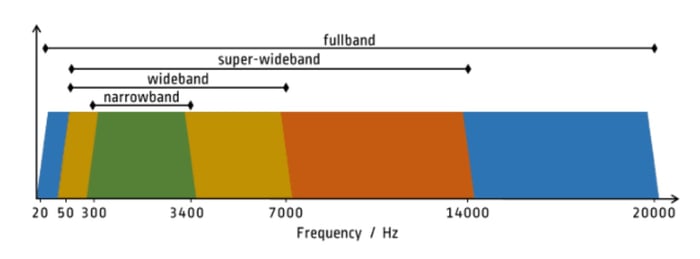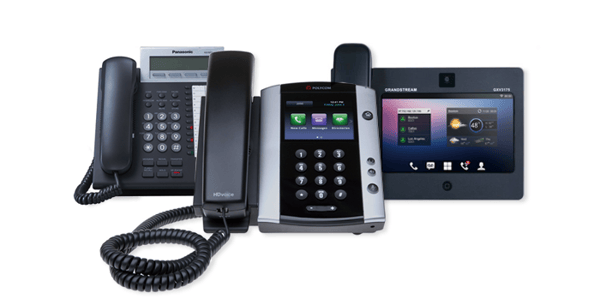Have you ever been on a business call that had crystal clear sound? Or maybe you've overheard a call on your coworker's speakerphone and you could've sworn that the person who your coworker was speaking with was actually in the room!
These types of calls are high-definition calls, but you might know them as wideband audio or "HD voice," just to name a few synonyms. In this blog, we'll present some introductory information on what HD calls are and how they work.
Quick Intro to HD Voice Codecs and Wideband Technology
Audio Codec
A codec is a program or algorithm that is used to convert audio (voice sounds) into a compressed, digitally encoded form and then back into uncompressed audio at the other end. The word "codec" is actually short for "coder-decoder," and quite a few different codecs exist, each of which may have different bandwidth and computational requirements. Many codecs are formalized by the International Telecommunications Union (ITU) into standards for use across different countries and devices.
The traditional telephone network is limited to the G.711 codec due to the technology and user devices upon which it relies. While the standard for landline phone calls, this "narrowband" codec typically results in grainy or staticky sounding calls. (No doubt you've experienced many of these types of calls yourself!)

Wideband Audio
Wideband audio technology uses a "wideband" codec that makes use of a greater frequency range of the audio spectrum when compared to narrowband codecs. Wideband technology transmits audio beyond the narrowband limit of 3.4 kHz, all the way up to 7 kHz. This expanded range results in excellent sound and speech quality: clearer phone calls and sharper, crisper voices.
The first standardized wideband codec, G.722, was developed in the late 1980s. It is now freely available because its patent has expired. Another HD voice codec, G.722.2, offers high-definition voice quality over smaller bandwidth transfer rates. However, the current “gold standard” of the wideband audio codecs is called Opus, and it's the default codec that's used by all WebRTC technology and apps currently available.
There are actually many different names used when referring to wideband audio technology. It is most commonly referred to as "HD voice," a term trademarked and popularized by Polycom, the well-known communications and collaboration technology provider. Other players in the industry may have other branded names— for example, Aastra calls their HD audio "Hi-Q." Typically, these names refer to a combination of the manufacturer's hardware/software design with wideband audio codecs.
How Do VoIP Phones Know Which Codec to Use?
End user devices, such as IP phones and softphones, typically support several different audio codecs. When two of these devices begin to talk with each other, they will negotiate which codec to use by looking at which ones they have in common. You can think of codecs as the different types of audio files on your computer. Just as a .wav player would not be able to play an .mp4, an IP phone would not be able to successfully communicate with another end user device if they did not share at least one codec.

Fact Versus Fiction: HD Voice Mythbusters
1. HD Voice Is New
HD voice technology has been around for longer than you might think. One of the most well-known implementations is Skype. Back when Skype was released in 2003, users immediately wondered why their Skype-to-Skype calls sounded so much better than what they were used to. It turns out that Skype was using a proprietary audio codec called iSAC that captured twice the voice frequency of PSTN calls and most of the VoIP calls at the time. In other words, Skype was a prime example of wideband audio technology at work.
2. HD Voice Is Costly
Years ago, most of the HD-capable VoIP phones on the market were “executive class” IP phones with MSRPs of more than $200. There were also only a few manufacturers that readily pushed the technology, so options were limited.
Today, almost all manufacturers of VoIP user agents offer HD-capable products. Many HD offerings also extend to the most affordable entry-level models. You can now pick up an HD VoIP phone for well under $100. Even some IP phones that once did not support the G.722 wideband codec have gone through firmware upgrades that now make them HD compatible.
3. All HD Voice Implementations Deliver the Same Voice Quality
Just because it no longer costs you an arm and a leg to get started with wideband audio does not mean that the saying “You get what you pay for” no longer applies. The cofounder of Polycom, Jeff Rodman, warns that IP phones with just HD codecs may not necessarily provide callers with true HD voice quality.
Although you could say that Rodman’s comment was meant to knock down competitors (particularly the manufacturers that made their devices “HD compatible” through a firmware upgrade), there is truth to his statement. Polycom's executive-class VoIP phones have specially designed speakers and microphones, Polycom's own patented acoustic software technology, and hardware specifications that maximize voice quality. It makes sense that these devices would sound better than an entry-level “HD-compatible” phone from another manufacturer.
OnSIP HD VoIP and High-Definition Calls
OnSIP was built from the ground up using open-source projects such as OpenSIPS, FreeSwitch, and Asterisk. Our service is also device-agnostic (as long as the device follows the SIP-RFC standards). Customers can bring their preferred IP phones and devices that support HD audio and they'll be compatible with OnSIP's HD VoIP and cloud phone system.
We're also huge supporters of WebRTC and have built a few features and apps that use this innovative technology. One such WebRTC application is the OnSIP app, our business softphone available in the browser or via a desktop application. Free for all OnSIP users, the OnSIP app also supports wideband audio codecs. Equip your staff members with this customizable app and they'll be able to make high-definition calls right from their computers or laptops.


